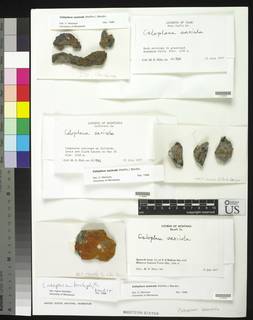
Consortium of Lichen Herbaria
- building a Global Consortium of Bryophytes and Lichens as keystones of cryptobiotic communities -
- Home
- Search
- Images
- Species Checklists
- US States: O-Z >
- US National Parks
- Central America
- South America
- US National Parks
- Southern Subpolar Region
|
|
|
|
Family: Teloschistaceae
[Aglaopisma murorum (Hoffm.) De Not. ex Bagl., moreAmphiloma murorum (Hoffm.) Körb., Amphiloma murorum f. murorum (Hoffm.) Körb., Amphiloma murorum var. murorum (Hoffm.) Körb., Callopisma murorum (Hoffm.) De Not., Callopisma steropeum (Ach.) Körb., Caloplaca discerenda , Caloplaca discernenda (Nyl.) Zahlbr., Caloplaca murorum (Hoffm.) Th. Fr., Caloplaca murorum f. discernenda (Nyl.) J. Nowak, Caloplaca murorum f. murorum (Hoffm.) Th. Fr., Caloplaca murorum var. murorum (Hoffm.) Th. Fr., Caloplaca saxicola (Hoffm.) Nordin, Caloplaca saxicola f. saxicola (Hoffm.) Nordin, Caloplaca saxicola subsp. saxicola (Hoffm.) Nordin, Caloplaca saxicola var. saxicola (Hoffm.) Nordin, Caloplaca steropea (Ach.) Poetsch, Gasparrinia murorum (Hoffm.) Tornab., Gasparrinia murorum f. murorum (Hoffm.) Tornab., Gasparrinia murorum var. murorum (Hoffm.) Tornab., Gasparrinia pusilla f. discernenda (Nyl.) Dalla Torre & Sarnth., Lecanora discernenda Nyl., Lecanora murorum (Hoffm.) Ach., Lecanora murorum f. illusoria Anders, Lecanora murorum f. imbricata Anders, Lecanora murorum f. murorum (Hoffm.) Ach., Lecanora murorum var. murorum (Hoffm.) Ach., Lecanora murorum var. pallens Dóy{?} ex T.P. Brisson, Lecanora steropea (Ach.) Nyl., Lichen murorum Hoffm., Lichen murorum var. murorum Neck., Parmelia murorum (Hoffm.) Ach., Parmelia murorum var. murorum (Hoffm.) Ach., Parmelia murorum var. steropea Ach., Physcia murorum (Hoffm.) A. Massal., Physcia murorum f. murorum A. Massal., Physcia murorum f. oncocarpa Körb., Physcia murorum var. murorum A. Massal., Placodium murorum (Hoffm.) DC., Placodium murorum f. murorum (Hoffm.) DC., Placodium murorum var. congestum Flagey, Placodium murorum var. leucothallum P.A. Genty, Placodium murorum var. murorum (Hoffm.) DC., Placodium steropeum (Ach.) Räsänen, Psora saxicola Hoffm., Squamaria murorum (Hoffm.) Howitt, Teloschistes murorum (Hoffm.) Norman, Xanthoria murorum (Hoffm.) Th. Fr., Xanthoria murorum var. miniata Th. Fr., Xanthoria murorum var. murorum (Hoffm.) Th. Fr.] |
Nash, T.H., Ryan, B.D., Gries, C., Bungartz, F., (eds.) 2007. Lichen Flora of the Greater Sonoran Desert Region. Vol 3. Life habit: lichenized Thallus: crustose, elongate lobed, margin abrupt at edge, with elongated lobes 1-2 mm long, 0.3-1 mm wide; prothallus: absent surface: orange, smooth, without asexual propagules cortex: cellular, 15-50 µm thick, granules absent, medulla prosoplectenchymatous or dense, without granules Apothecia: immersed or adnate, 0.4-1 mm in diam., lecanorine disc: orange, flat, epruinose margin: persistent, flush or slightly raised; thalline margin present, concolorous with thallus; proper margin not visible or visible, concolorous with disc parathecium: cellular (paraplectenchymatous); exciple below hypothecium amorphous epihymenium: golden, K+ red, H-, 10%N-, cN-, C- hymenium: hyaline, 70-85 µm tall paraphyses: 2-3 tip cells swollen, not branched; subhymenium hyaline asci: cylindrical, 8-spored ascospores: hyaline, 2 locules, ellipsoid, 11-14 x 5.5-7 µm, isthmus 2-4 µm, spore end wall thin Pycnidia: present, totally immersed, ostiole orange Spot tests: apothecial margin K+ red, H-, 10% N-, cN-, C-; thallus K+ red, H-, 10%N-, cN-, C-; medulla IKI- Secondary metabolites: parietin, fallacinal, emodin, and teloschistin. Substrate and ecology: on non-calcareous or calcareous rocks World distribution: worldwide Sonoran distribution: southern California, Arizona, Baja California, and Baja California Sur. Notes: Caloplaca saxicola has a small thallus with short lobes that sometimes look inflated with apothecia developing near tips of lobes. It is similar to C. ignea and C. impolita but they have larger thalli with apothecia developing near the center of the thallus. |
|
|
|
Powered by Symbiota







































































































